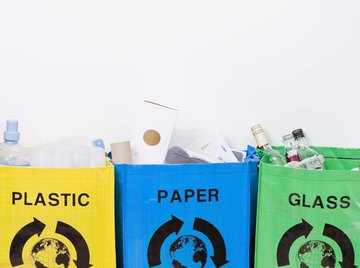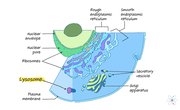
Lysosomes are organelles that digest and dispose of unwanted protein, DNA, RNA, carbohydrates, and lipids in the cell. The inside of the lysosome is acidic and contains many enzymes that break down molecules. It is referred to as the cell’s recycling center, but that does not it mean only plays a passive role in the cell.
Aside from breaking down unwanted molecules, and even other organelles, its recycling function is at the center of a process called autophagy, in which the cell digests itself. Autophagy is triggered when the cell is under stress and is one way in which a cell undergoes senescence, or growth arrest, to preserve energy. Lysosomes are also essential components of macrophages, which defend the body against pathogens.
Acidic Content
The lysosome is a membrane pouch that pumps protons, or hydrogen ions, into its center, causing its insides to have an acidic pH of 5. It contains 50 different types of enzymes, called hydrolases, that break the chemical bonds that hold molecules together.
Lysosomal enzymes are unique in that they only function in an acidic pH, as opposed to the relatively neutral 7.2 pH of the cytoplasm. This is a safeguard for the cell, in case the lysosome pouch breaks and the enzymes are released. If the enzymes got into the cytoplasm, they would break down and destroy essential cell components, which would harm the cell and the organism.
Recycling Centers
Lysosomes form from small pouches, called vesicles, that bud off from the Golgi complex -- the "post office" that sends pouches throughout the cell. The lysosome pouch then fuses with endosomes, which are pouches that pinched in from the cell surface membrane. The new pouch resulting from this fusion becomes the mature lysosome.
Lysosomes digest whatever is inside them, which can be particles engulfed from the cell's external environment or organelles and molecules that are inside of the cell. The bits and pieces that result from the digestion of molecules can then be recycled to make new things, including:
- Protein
- DNA
- Sugars
- Fats
They can also broken down even further instead of being recycled. Immune cells, such as macrophages that engulf foreign particles and pathogens, have many lysosomes to break down these foreign intruders.
Autophagy and Senescence
When cells are stressed because of a chemical imbalance, such as too many dangerous oxygen radicals produced by the day-to-day chemical reactions in the cell, it undergoes a form of growth arrest called senescence. Oxygen radicals are unstable molecules that break chemical bonds in other molecules, and can cause mutations. Senescence is a process in which the cell stops growing and becomes dormant.
Part of what happens in senescence is a process called autophagy, or self-eating, during which the cell begins to digest its own organelles. Lysosomes are the main organelles that perform autophagy.
Lysosomal Diseases
There are 30 different human diseases that result from mutations of genes that encode for enzymes in a lysosome -- they are called lysosomal storage diseases.
One such disease is Tay-Sach’s disease, which causes mental retardation and other nerve problems. This disease is caused by a mutation in a gene that is responsible for digesting a fat molecule that is found in brain cells. Lysosomes in Tay-Sach’s patients are clogged with this fat molecule, called a GM2 ganglioside, which causes them to swell and disrupt the function of the brain cell.
Another example is called Fabry disease. This disease is caused by a rare mutation in the GLA gene. This causes affected individuals to have a lower concentration of an enzyme that breaks down the fat molecules GL-3 and GB-3. Like Tay-Sach's disease, this "clogs" the lysosome and prevents proper functioning, leading to severe pain, strokes, heart attacks, and more at a very early age.
References
- The Cell: A Molecular Approach: Lysosomes
- Encyclopedia Britannica: Hydrolases
- Fight Aging: How Age-Damaged Mitochondria Cause Your Cells To Age-Damage You
- Current Opinion in Cell Biology: Connecting autophagy to senescence in pathophysiology.
- A.D.A.M. Medical Encyclopedia: Tay-Sachs Disease
- Basic Neurochemistry: Molecular, Cellular and Medical Aspects: Lysosomal Disease
About the Author
David H. Nguyen holds a PhD and is a cancer biologist and science writer. His specialty is tumor biology. He also has a strong interest in the deep intersections between social injustice and cancer health disparities, which particularly affect ethnic minorities and enslaved peoples. He is author of the Kindle eBook "Tips of Surviving Graduate & Professional School."
Photo Credits
Jupiterimages/Polka Dot/Getty Images
